 The first thing that came to mind when I pulled the Hawkeye Compact out of the bulk shipping carton was where the rest of the gun might be. The box is approximately two thirds the length of the other rifles and it feels almost empty. It took a few moments, but then it sunk in that even through it is a bolt action rifle, it is still only 35″ long and weighs just 6 lbs.
The first thing that came to mind when I pulled the Hawkeye Compact out of the bulk shipping carton was where the rest of the gun might be. The box is approximately two thirds the length of the other rifles and it feels almost empty. It took a few moments, but then it sunk in that even through it is a bolt action rifle, it is still only 35″ long and weighs just 6 lbs.
I dug around in my scope cabinet until I located an older 3-9x variable compact scope with excellent eye relief, installed it with the Ruger rings that were supplied with the rifle. A quick boresight and the set up was ready to go.
The .308 Winchester
This particular example was chambered for the .308 Winchester, a cartridge I have ignored for most of my adult life, so I didn’t really know what to expect from the gun. I’ve always thought of the cartridge as sort of a 30-06 Short. It is the “Almost as good as…”, “Almost as fast as…” cartridge that has no remarkable characteristics.
Sure, it may arguably be the cartridge most ideally suited to North American hunting. Sure, it may also arguably be one of the most accurate cartridges…OK, and it may even be one of the easiest cartridges to shoot well but… We’ll, where is the challenge in all of this?
| M77® Hawkeye® Compact | |
| Model | HKM77CRBBZ |
| Type | Bolt Action |
| Chamber | .308 Winchester |
| Weight | 6 lbs 1 Oz. |
| Barrel Length | 16 1/2″ |
| Twist | 10″ RH |
| Magazine Capacity | 4 Rounds |
| Hardware | Stainless Steel |
| Trigger Type | LC6 Non Adjustable |
| Trigger Pull | 5 Lbs 2 Oz. |
| Safety | 3 Position |
| Stock | Black – Laminated Birch |
| Overall Length | 35 1/2″ |
| Stock – Pull | 12 3/4″ |
| Stock – Drop at Comb | 3/4″ |
| MSRP | $862 |
Then there is the issue of the missing lever…

If there was ever a bolt action rifle that felt like a saddle carbine when carried, this is it. I could have used this a hundred years ago when I was trudging around in the Black Hills, butt deep in snow and hanging onto rocks so I wouldn’t slide off of a hill. Even with compact scope and rings in place, the rifle weighs barely over 7 lbs and it is smaller than a traditional saddle carbine. The short stock pull length pull brings the rifle’s CG toward the shooter, but the shortened forearm brings everything back into balance. The result is a short barrel that is very steady on target and one that one that doesn’t get away from the shooter when tracking to a moving target. While the M77® Hawkeye® Compact is a fun recreational shooter, it is obviously a hills and woods country hunting rifle.
Details, details, details…
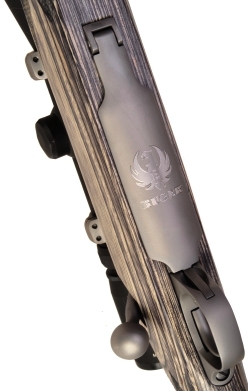 Before I spent much time with Ruger firearms, I always categorized them as Plain-Jane. The term “ignorance is bliss” does define my once stress free lifestyle. When I finally got to push some ammunition through Ruger firearms, and I was able to get a closer look at them, the simple elegance of their mechanical design became obvious. Makes sense for a company that was founded by an east coast gun designer with an appreciation for art and excellence is design.
Before I spent much time with Ruger firearms, I always categorized them as Plain-Jane. The term “ignorance is bliss” does define my once stress free lifestyle. When I finally got to push some ammunition through Ruger firearms, and I was able to get a closer look at them, the simple elegance of their mechanical design became obvious. Makes sense for a company that was founded by an east coast gun designer with an appreciation for art and excellence is design.
The Hawkeye M77 Compact has a hinged floorplate to make unloading easy. The floorplate release, recessed into the front of the trigger guard, makes for easy operation, but also keeps the catch out of reach of misplaced fingers. The finish on stainless parts is matte; always good to go into the woods with something less that reflector mirrors on your arm. The Ruger Hawk is cut into the floorplate in a tasteful fashion.
The guard is secured with two screws that pass through the stock and into the action. The floor plate is secured with one larger fastener at approximately a 45° angle to the action. The stock and bottom hardware fit cleanly together and there is nothing that shoots loose or looks out of place.
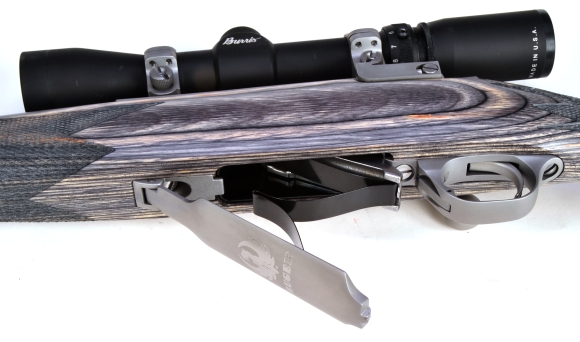

The Hawkeye has a very attractive black laminated stock, produced from RPC’s proprietary Stratabond birch laminate. It is amazing how much laminated stocks have improved in durability and appearance since their early use on factory firearms. The Ruger stock is very durable, weatherproof and nicely finished all the way through to the inletting and controlled barrel channel contact. The checkering is very clean and there is some interesting coloration in the wood. The most important aspect of this stock is its dimensional stability which really pays off when hunting is severe weather conditions.
Ruger’s casting technology is top notch, although I am not crazy about some of the minor parting lines. Functionally they mean nothing, they don’t interfere with operation and they never appear on handling or bearing surfaces. I’m just very old and cranky and I like perfection in everything. So why am I writing about them. I honestly don’t know other than I don’t like seeing them in my photos.
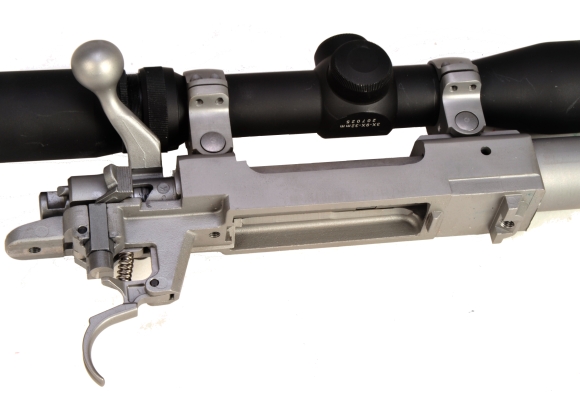
The M77’s flat bottomed action mates concisely with the laminated stock and is, again, secured convincingly at three points long its bottom. The action is smooth when opening and closing for a controlled feed gun. The Ruger scope mount system is very reliable and the fact that Ruger includes a set of 1″ rings is commendable. They hang on tight with even very heavy cartridge applications, 30mm tube size rings are readily available and the little cross tab under the rings locate scopes positively fore and aft.
The three way safety is positive in actuation and the LC6 trigger is pretty…spiffy. At a hair over 5 lbs, the trigger has to have one of the shortest releases of almost any rifle on the market. There isn’t a whole lot of tugging distance there to allow pulling off the target before the firing pin drops and the Ruger has reduced lock time. The trigger does not have provisions to adjusting things like pull weight, or over travel, however, anything can be adjusted by a gunsmith given enough hammer weight and grinder speed. That said, I do believe the notion that triggers on all hunting rifles need to be light is…uninformed.
“The perfect weight is 3 lbs 4 oz…” is an actual quote from one writer. First of all, weight is relative to the person feeling its resistance and there is no way for every person’s perception of a weight to be the same. Secondly, pull weight is often a general characterization of a trigger which may ignore pull length, creep, overtravel, etc… The closest I’ve come to agreeing with a proper pull description is “…like breaking glass”. The Ruger trigger is very good. It is not so light it could be depressed without a conscious effort to do so and its quick sear release is clean like breaking glass…only without all the bleeding.
Hey! How about those Giants!

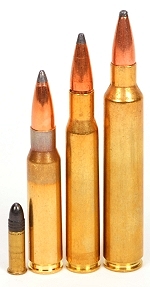
I don’t know how to place the .308 Winchester into context with popular cartridges. I know the lineup to the right, But I am not sure what logical arrangement I can place on the left as the .308 Winchester is about as short and small in case head diameter as an almost modern hunting cartridge can get. OK, let’s try this. While some cartridges are larger than the .308 Winchester, the .30-06 Springfield and .300 Remington Ultra Mag to name two, the .308 Winchester can dwarf other cartridges…like the .22 LR.
The designers of the .308 Winchester must have been doing something right as the cartridge has been responsible for more spinoffs than a popular sitcom; 358 Winchester, 243 Winchester, .260 Remington, and 7mm-08 Remington. With a 2.810″ COL and 0.473″ case head, the .308 Winchester is a lean, mean….lean mean. The .308 Winchester holds all of the entertainment value of a Saturday afternoon bass fishing show, or perhaps the Food Network during “Cake week. And I sincerely mean that.
Enough with the accolades…

I picked up a set of Lee Precision RGB dies because they did not include yet another shell holder that follows the .30-06 Springfield standard and I did not need another yellow handloader’s sippy cup like powder measure. The ramifications of that executive decision was a fiscal exposure of $15.The Lee Precision RGB set is less costly than even other Lee die sets because only a sizer and seater are included. They are nicely finished and they make good ammunition. If I wanted something different, there are approximately 52 types/set of reloading dies for the .308 Winchester. Someone had a lot of time on their hands.
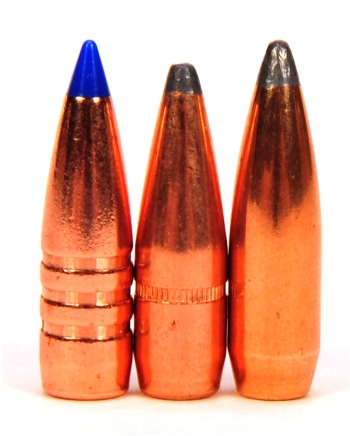
The first thing I noticed about bullets for the .308 Winchester is that they are REALLY big, pictured right – actual size. I suspect, if thrown, they could be a very effective game getter and they are a natural selection for a hard to misplace bullet keychain. In a real world context, over a third of my loading bench space is populated with one variety of .308″ bullet or another.
I thought Barnes 130 grain TTSX, Hornady 150 grain soft point boat tail and Sierra 165 grain soft point boat tail bullets would be representative of the gun’s capability; accuracy, consistency of shot placement, and terminal ballistics. With 56 grains of powder capacity, the Ruger with 16.5″ barrel has approximately the same expansion volume as a .30-06 Springfield with a 22″ barrel, so the short barrel does not carry the ballistic compromise one might expect. With 95% of a powder charged burned in the first 11″ bullet travel, how much more barrel is needed?
Test barrels for the .308 Winchester can fall between 20″ and 26″ in length. Barnes data was based on a 24″ barrel, Hornady’s data on a 22″ barrel and Sierra utilized a gun turret like 26″ barrel. Hodgdon BL-2(C) powder was used for all loads so powder type changes would be one less influence to interpret.
Component manufacturers are emphatic in their universal caution to of not substituting bullets of the same weight within a data set without properly compensating for variation in shank length by adjusting powder charge or cartridge overall length. The current version of the Barnes Reloading Manual #4 lists data only for their earlier 130 Grain TSX #30838, which is approximately 0.080″ shorter than the 130 Grain TTSX #30873. This of course means the data cannot be carried over to the new bullet as its longer shank would seriously elevate pressure if loaded to the same COL as the short bullet. The 130 Grain TTSX’s longer shank improved bullet retention and the nose appears to have been reshaped which, combined with the poly tip, yields an improved BC. In developing loads for the new 130 Grain TTSX, the longer shank further proved advantageous as approximately the same velocity was achieved with less powder. When handloading cases that had been sized full length, fitting the original charge required a high degree of compression. With the downward adjusted charge as an offset to the newer bullet’s shank length, the heaviest load was only lightly compressed. Thank you. I appreciate your attention throughout that long winded public service announcement.
| Bullet Type | Weight Grains |
Bullet Length “ |
COL” | Powder | Charge Grains |
Listed Velocity |
Actual Velocity1 |
| Barnes TTSX | 130 | 1.174 | 2.810 | BL-C(2) | 51.0 | 3189 (24″)* | 3005 |
| Hornady | 150 | 1.100 | 2.735 | BL-C(2) | 50.0 | 2800 (22″) | 2880 |
| Sierra | 165 | 1.180 | 2.750 | BL-C(2) | 44.8 | 2700 (26″) | 2534 |
| 1 Velocity recorded with 16 1/2 2 Calculated – Barnes manual does not include the TTSX Note – CCI large rifle primers were used for all loads |
|||||||
I love Partizan cheese on…
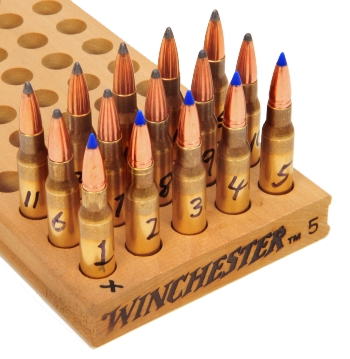
Beginning with new Prvi Partizan brass with a measured case capacity of 55.0 grains, once fired brass expanded to 57.6 grains. A useful pickup. There are a number of powders, when loaded with 150 grain or lighter bullets, where a couple of grains determines whether or not they can be loaded to an acceptable level of performance. If I were to load the .308 Winchester on a routine basis, I’d lean toward making critical loads from fired brass that had only been neck sized.
The .308 Winchester is an extremely easy cartridge to handload, wear and tear on brass is negligible and it has to be the king of bullet to case concentricity. Fifteen of tightly controlled handloads were assembled to check rifle function and to establish bullet to rifling clearance. Many more rounds were quick to follow.
Tick avoidance and groups shot at fifty yards…
My lovely wife of 42 years is quite Irish. I am, on the other hand, very much Italian. She can walk through the woods of Maine and never get so much as a mosquito bite where as I am bitten by any form of biomass that swims, walks, crawls or flies. Clearly we have differing opinions as to why that circumstance exists, but we both agree it is a fact. I haven’t had a chance to clear the range out back yet, so fifty yards was about all I was willing to risk for the sake of firearm testing in the face of tick borne Lyme disease. I do believe that, fifty or one hundred yards, the results are an accurate indication of the Ruger’s capabilities.

Normally I have to work a little bit to tighten up Barnes TTSX bullet. Not much, just a little finessing. The group at the left represents the first three shots through the gun and the first load I put together for the .308 Winchester. Subsequent shooting with the same load resulted in virtually the same results. The gun, with a ten inch twist, seems to like the longish 130 grain Barnes bullet and my experience with Barnes solid material bullets tells me this is a very good hunting selection.

OK, slightly warm barrel but not enough to warm my coffee. The first shot went wide right, the other two shared a hole. Doesn’t matter as none were far enough a part of let a deer walk through…even a very tiny deer. This load was accurate and velocity was actually higher than the Hornady data which was based on a 22″ barrel. The 150 grain Hornady did well.
 This was actually the second group shot, so the vertical stringing was not developing as barrel temperature was rising. 165 grains is an OK bullet weight for the .308 Winchester, and a half inch group isn’t anything to sneeze at as group sizes go. I did manage to extend bullet weights and try a few more powder selection and the combination appears to be innately accurate. In short, while I would like to take credit for the rifle and cartridge accuracy, I probably could have shot off the shelf ammo and the results would have been similar.
This was actually the second group shot, so the vertical stringing was not developing as barrel temperature was rising. 165 grains is an OK bullet weight for the .308 Winchester, and a half inch group isn’t anything to sneeze at as group sizes go. I did manage to extend bullet weights and try a few more powder selection and the combination appears to be innately accurate. In short, while I would like to take credit for the rifle and cartridge accuracy, I probably could have shot off the shelf ammo and the results would have been similar.
Shooting Impressions
 Interesting little gun, and that was the opinion of any number of people who were greeted at the shop by me saying, “Here. What do you think of this?” Everyone initially thought the gun was too small, but as soon as they picked it up and brought it too their shoulder they sang a different tune. The little Ruger became a comfortable natural pointing gun that felt very balanced and steady.
Interesting little gun, and that was the opinion of any number of people who were greeted at the shop by me saying, “Here. What do you think of this?” Everyone initially thought the gun was too small, but as soon as they picked it up and brought it too their shoulder they sang a different tune. The little Ruger became a comfortable natural pointing gun that felt very balanced and steady.
Shooting pretty much left every everyone with the same impression; lots of muzzle blast, very low recoil and an easy gun to shoot accurately. The cause of the muzzle blast is the short 16.5″ barrel leaving about 12,200 PSI of muzzle pressure as compared to a 24″ barrel with less than 8,000 PSI of muzzle pressure. The recoil minor, to the point it was surprisingly light. It has to be the stock design because even the big .416 Ruger fired in a Hawkeye M77 demonstrates very manageable recoil. There was that one guy who referred to the gun’s recoil as “sassy”, but he’s no longer allowed in the shop and “sassy” was added to the list of fifty one…now fifty two words that may never be spoken when describing a firearm in the shop.
As I said at the opening of the article, the Hawkeye M77 Compact is an excellent woods rifle. It is made with the understanding that hunting rough terrain takes a lot of energy and effort. Making a gun in the right caliber at the lightest possible weight is a good place to start when making practical hunting gear.
The gun for all occasions…
I’ve often given Ruger a lot of credit for making guns to fit many applications. The Hawkeye Compact is no different. Besides .308 Winchester, the Compact is also chambered for the: 223 Remington, .243 Winchester, .260 Remington, 7mm-08 Remington, .300 Ruger Compact Magnum, 7.62x39mm, and 6.8mm Remington SPC.
Ruger’s M77® Hawkeye® Compact Part I
Ruger’s M77® Hawkeye® Compact Part II

Email Notification